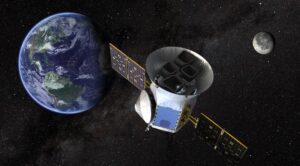TESS begins science observations

WASHINGTON — A NASA spacecraft launched in April to search for exoplanets around nearby stars has started science observations, the agency said July 27.
The Transiting Exoplanet Survey Satellite (TESS) officially started science observations July 25, according to a NASA statement. The spacecraft, launched April 18 on a SpaceX Falcon 9, is now in its final 13.5-day orbit around the Earth and has completed checkout of its cameras.
“I’m thrilled that our new planet hunter mission is ready to start scouring our solar system’s neighborhood for new worlds,” Paul Hertz, head of NASA’s astrophysics division, said in the statement about TESS.
At the time of launch, NASA said that TESS would begin science operations about 60 days after launch. The agency didn’t explain why the commissioning took more than a month longer than expected, although in a July 11 statement NASA said that the spacecraft was in good health and it expected science operations to begin by the end of July.
TESS will search for exoplanets by looking for them as they pass in front of, or transit, the stars they orbit. These transit cause minute, periodic dips in brightness of the stars that the cameras on TESS will detect. NASA expects TESS will find thousands of exoplanets during the course of its mission, with a particular focus on those around relatively nearby stars.
The first sector of sky that TESS will observe is a band of the southern hemisphere encompassing 2,300 square degrees from the south ecliptic pole to near the ecliptic plane, said George Ricker of the Massachusetts Institute of Technology, the principal investigator for TESS, in a talk at a meeting of NASA’s Exoplanet Exploration Program Analysis Group (ExoPAG) in Cambridge, Massachusetts, July 29.
The first downlink of data from those observations is planned for Aug. 8. “We’ll be analyzing the data, trying to improve operations gradually over the first few months,” he said. “The news is excellent.”
Over its two-year primary mission TESS will be able to observe about 85 percent of the sky, spending the first year studying the southern hemisphere and the second year the northern hemisphere. Project scientists are optimistic, though, that TESS will be able to operate for long after that primary mission.
TESS uses the same technique to look for exoplanets as NASA’s Kepler mission, launched in 2009. Kepler focused on a single area of the sky for its first four years but, after the failure of two reaction wheels on the spacecraft ended those observations, went into an extended mission called K2, carrying out a series of “campaigns” of observations of different regions of the sky for nearly three months at a time.
NASA said July 6 that Kepler had gone into a fuel-conserving safe mode, prematurely ending a set of observations known as Campaign 18. That took place after engineers noticed an “anomalous” drop in fuel pressure in the spacecraft that could be a sign that the spacecraft is running out of fuel, which would end its mission.
At the ExoPAG meeting, Gary Blackwood, manager of NASA’s exoplanet exploration program, said that the data Kepler collected during Campaign 18 will be transmitted back to Earth Aug. 1. “Campaign 19 will begin as planned on Aug. 6,” he said, although NASA stated last month that the start of the next campaign, and its duration, would depend on the status of the spacecraft.
from SpaceNews.com https://ift.tt/2LKDviy
Comments
Post a Comment